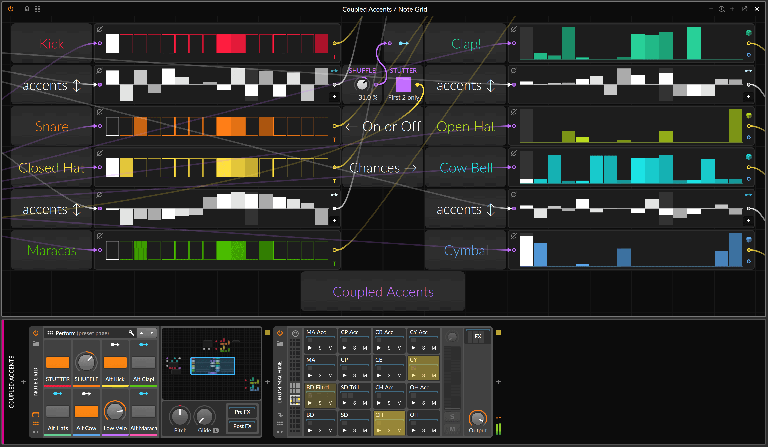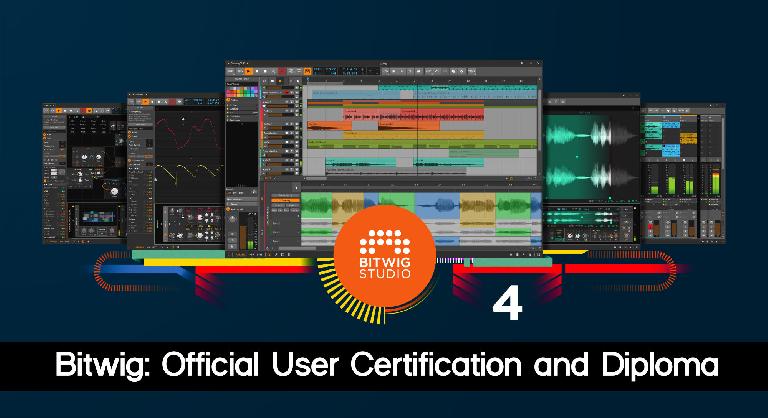Bitwig Studio 4.2 Is Coming Soon
Ask.Audio Staff on Feb 15, 2022 in News | 1 comments
Berlin February 15, 2022 — What sounds good? We got inspired by some classic audio effect units and then made a suite of excellent effects for Bitwig Studio 4.2. Please welcome new choruses, flangers, phasers, and just one more note FX to the family.
Watch The Video
New Audio FX
They may look like three new devices — Chorus+, Flanger+, Phaser+ — but they're really more like 12. Each device has four unique Characters that have their own DSP architecture, similar to different eras of vintage studio hardware. And each was designed to have range and sound good. Like, really good.
Chorus+ Characters
CE - A synth-style friend, with different tone inspirations
DD - Subtle, 80s, and coming from all sides
8v - Eight voices swirling thru caverns of feedback
x2 - Classic voice doubling circuit
Flanger+ Characters
DP - That digital, scrapy cousin who chews up sound
MX - A firm, pedal-style classic
TFX - Smooth and sparkly, with some edge
WA - Stronger, but subtly delicate
Phaser+ Characters
GS - Our spikey #1 friend
EHx - Classy and smooth, with silky motion
MX - A raspy devil, but solid
MF - Pleasantly greasy and deep
We spent a lot of time and care shaping each Character, including the LFOs that make each sound move. But you can also “override” Flanger+ or Phaser+ and get direct control. By mixing and matching LFOs, step sequencers, and any of Bitwig’s 38 modulator devices, you are free to animate our algorithms and make them your own.
And Chorus+, Flanger+, and Phaser+ are also available as Grid modules. So throw these full effects into any Grid patch, with the freedom to craft a stereo modulation signal or make it fully polyphonic. As always, whatever you can imagine is possible in The Grid.
Watch The Tutorial Video
Note Grid
The Grid is Bitwig Studio's modular sound-design environment, where building instruments and audio effects with Poly Grid and FX Grid is effortless, intuitive, and fun. Bitwig Studio 4.2 introduces a third device: Note Grid. With access to The Grid’s 184 modules and polyphonic structure, Note Grid is made to process notes or even generate them.
With the new Note Out module, connecting a gate signal will start outputting notes. Pitch, velocity, and channel can be set manually or with dynamic signals. And since Bitwig fluently speaks MPE, unfolding Note Out allows signals for each note’s timbre, pressure, gain, and panning expressions. As with all other Grid modules, Note Out(and CC Out) are available to Poly Grid and FX Grid as well.
Eight musical presets are included today, including new kinds of arpeggiators, swarming polyphonic randomness, modular drum sequencers, and even music-generating patches. The presets are production-ready, and together they show a range of possibilities with Note Grid.
Learn More In The Video
And Some More
4.2 has some further miscellaneous updates to mention.
- New mini views for the Oscilloscope and Spectrum devices. With new audio effects in the works, it was especially handy to have mini views for devices that visualize their effects
- A new Anti-aliasing option for most Grid Shaper modules
- And a new Hard Clip module joining the team
- A new Channel-16 modulator. Since Note Grid can sort signals into16 MIDI channels, the new Channel-16 modulator helps you use those groupings on any instrument or plug-in.
- And when generating notes with a module like Probabilities, it just made sense to add a Confidence output, good for per-step velocities or just a little self-assurance
- Bitwig is now available in French
Sign up to get your Official Bitwig End-User certification (March 22)
This class consists of three live interactive sessions, plus three on-demand video courses. Attend the 3 lecture sessions to learn new skills and get mentored by Bitwig Certified Trainer, Thavius Beck. And once you complete certification, you get the official Bitwig Diploma and a badge on the Bitwig site. All attendees will also receive an official Ask.Video completion certificate.
Become a Bitwig Studio Pro with these Ask.Video Courses
Download Bitwig Studio: https://www.bitwig.com
Learn Bitwig Studio at Ask.Video: https://ask.video/library/application/bitwigstudio
Sign up to get your Official Bitwig End-User certification (March 22): Ask.Video Bitwig Classroom







 © 2024 Ask.Audio
A NonLinear Educating Company
© 2024 Ask.Audio
A NonLinear Educating Company
Discussion
It’s also interesting that the video about the Note Grid focuses almost exclusively on the nine presets currently included. It’s probably a good strategy for a wider public since there are some obvious misunderstandings about the whole Grid system. At the same time, for those of us who’ve had a Note Grid at the top of our feature wishlist for years, it can almost feel like a joke. “You mean, you want to get people into the Note Grid with these examples? Interesting.”
Not that the examples are bad. They’re unique enough that the lightbulb might turn on in people’s heads. It’s just that…
To get what the Note Out module means for the whole of Bitwig, there needs to be some recall of Bitwig’s whole piece about modularity, when they came out with BWS3 and the first two Grids. I used the same analogy at work for something completely different yet it probably works best here: it’s like watching the end of a movie like Fight Club (or The Usual Suspects) and suddenly putting all the pieces together from the beginning. Because when you get (audio rate) modulators, CV I/O, support for HW devices, MPE, audio rate connections in the Grids, addressing plugin parameters, macros, Note FX, probabilities in clips, and this Note Out module together, you get a really unique recipe which can produce an overwhelming variety of things while remaining easy to understand and use.
It’s a great time to a Bitwig Studio user. And a great time to be alive.
Want to join the discussion?
Create an account or login to get started!